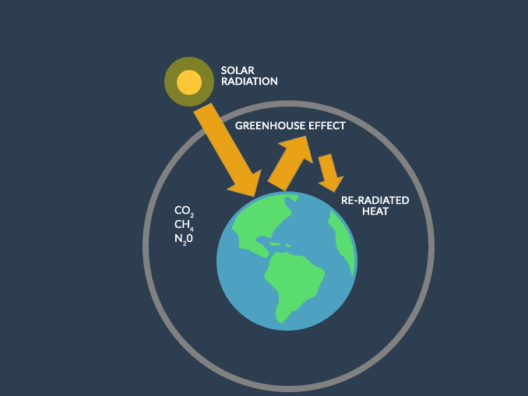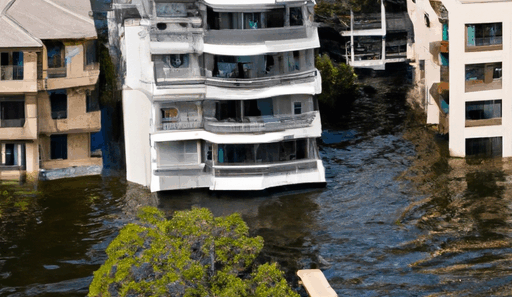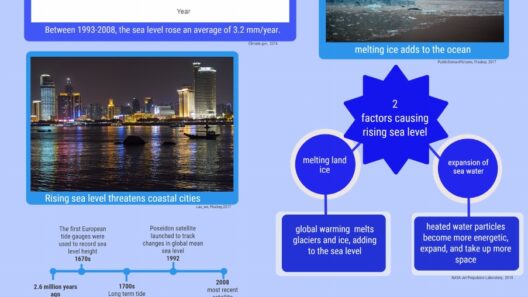Sea level rise is an increasingly critical aspect of climate change, manifesting as a formidable challenge that affects ecosystems, communities, and economies worldwide. As the planet warms, the expansion of seawater, coupled with the melting of glaciers and ice sheets, points to a pervasive threat. But is sea level rising uniformly across the globe? Understanding this phenomenon requires a nuanced exploration of local variances and global trends.
The Mechanics of Sea Level Change
To grasp the intricacies of rising sea levels, one must first understand the basic mechanics behind it. Two primary factors contribute to sea level fluctuations: thermal expansion of the oceans and the contributions from melting ice. When ocean temperatures increase, water molecules expand, leading to higher sea levels. Concurrently, glaciers and polar ice sheets, primarily located in Greenland and Antarctica, release vast amounts of freshwater into the oceans as they melt. This dual mechanism is exacerbated by climate change, with greenhouse gas emissions driving temperature rises across the globe.
Yet, the rate of sea level rise is neither uniform nor consistent. The Intergovernmental Panel on Climate Change (IPCC) suggests that global average sea levels have risen by approximately 20 centimeters since 1900. However, this average encompasses a wide array of regional disparities, influenced by geographical, geological, and oceanographic factors.
Regional Disparities: A Closer Look at Local Variances
While the global average might give a broad perspective, individual coastal regions experience unique dynamics in sea level changes. For instance, in some areas, sea levels are rising significantly faster than the global average. Coastal cities like Miami, New Orleans, and New York face challenges as local sea levels rise at rates up to three times the global average. Factors such as land subsidence—a result of natural compaction of sediments or human activities like groundwater extraction—compound the threat. In these locales, the combination of sinking land and elevating seawater creates a precarious situation.
Conversely, there are regions where sea levels are not only rising at a slower pace but are reportedly declining. For example, certain areas in northern Canada are experiencing falling sea levels due to isostatic rebound—where land previously depressed by enormous ice sheets during the last Ice Age is slowly rising back. These geological dynamics demonstrate that sea level trends cannot be generalized across the planet, underscoring the importance of regional studies.
The Socio-Economic Implications of Rising Sea Levels
As ocean levels rise, the socio-economic implications are profound. Coastal populations, often the most vulnerable, confront potential displacement and loss of livelihood. The World Bank predicts that by 2050, nearly 240 million people could be forced to relocate due to climate-induced displacement largely attributable to rising seas. Urban areas, with their dense infrastructures, are particularly at risk. Increasing flooding and storm surges threaten essential services and economic stability.
Moreover, the impact on freshwater resources cannot be overlooked. In low-lying coastal regions, saltwater intrusion into aquifers jeopardizes drinking water supplies and agricultural productivity. This intrusion not only exacerbates food security issues but also presents an array of public health challenges, as contaminated freshwater sources can lead to various ailments.
For nations with extensive coastlines, such as Bangladesh and the Maldives, the intersection of sea level rise with socio-economic vulnerabilities is striking. These countries often lack the robust infrastructure to accommodate sudden surges in flooding, making them uniquely susceptible to the effects of climate change. Thus, comprehensive adaptation strategies are essential to mitigate the impacts of rising sea levels.
The Role of Policy and Community Resilience
Addressing the challenges posed by rising sea levels necessitates robust policy interventions and community engagement. Governments and local authorities must collaborate to create foresight-driven strategies aimed at promoting coastal resilience. This entails not only infrastructural investments, such as seawalls and storm surge barriers, but also the development of nature-based solutions like restoring mangroves and wetlands that provide natural buffers against storm impacts.
Moreover, community involvement plays a pivotal role in cultivating resilience. Local populations possess crucial knowledge about their environment and can spearhead initiatives that address specific vulnerabilities. Education and awareness-raising campaigns can empower communities, fostering a culture of preparedness and proactive adaptation to the evolving climate landscape.
In addition, international cooperation is paramount in combating the effects of rising sea levels. Climate change is a global issue that transcends borders, necessitating a concerted effort to share knowledge, resources, and technologies. By synergizing efforts, countries can work towards sustainable solutions that safeguard both the human and ecological domains.
In Conclusion: A Collective Responsibility Towards Innovations
Sea level rise is not just a distant threat; it is a current reality that necessitates immediate action. The evidence demonstrates that while the world confronts a rising tide of challenges, the response must be multifaceted. Societies must not only adapt to the realities of changing sea levels but also work collectively to innovate for a sustainable future. Understanding the differential impacts of sea level change is crucial for creating tailored strategies that safeguard vulnerable ecosystems and enhance community resilience. Only through concerted global efforts can we hope to mitigate the consequences of this pressing environmental challenge.








